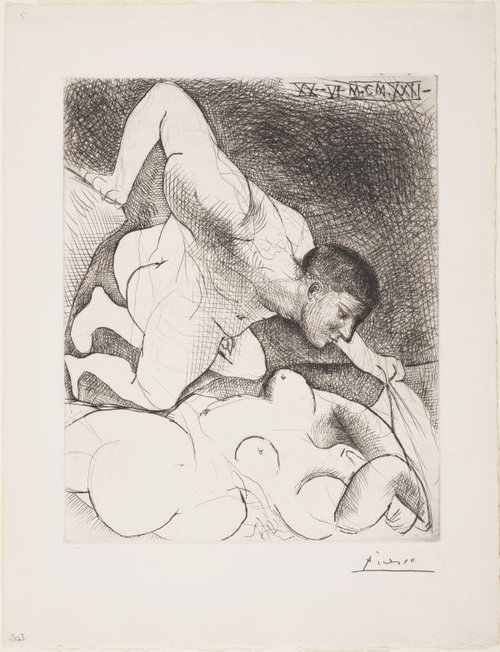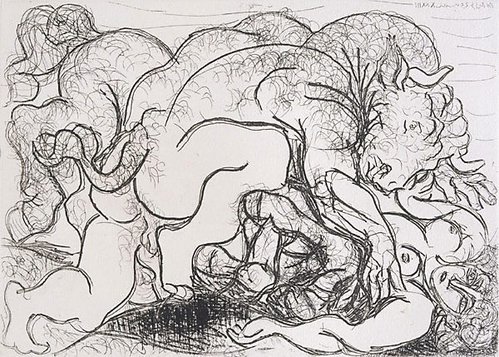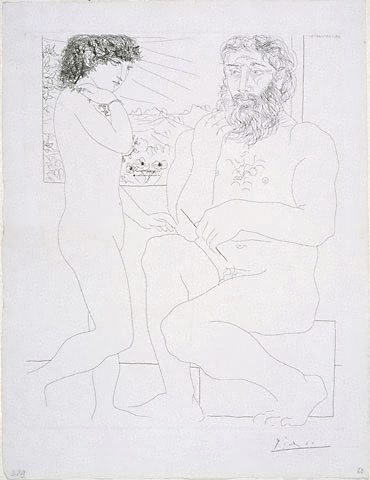-
Details
- Alternative title
- Sueño y Mentira de Franco
- Date
- 1937
- Media category
- Materials used
- etching and aquatint on Chine collé
- Edition
- 26/150 [there were also 30 signed artist's proofs numbered in Roman numerals and a stamp-signed edition of 850 on Montval]
- Dimensions
- 31.5 x 42.2 cm platemark; 38.2 x 57.5 cm sheet
- Signature & date
Signed l.r., pencil "Picasso". Dated top c., [etched in plate] "8 janvier 1937 [reversed]". Dated l.r., [etched in plate] "9 janvier 1937 - 7 juin 37 [reversed]".
- Credit
- Purchased with funds provided by Hamish Parker, Guy & Marian Paynter and Ashley Dawson-Damer AM 2017
- Location
- Not on display
- Accession number
- 339.2017.2
- Copyright
- © Pablo Picasso/Succession Pablo Picasso. Copyright Agency
- Artist information
-
Pablo Picasso
Works in the collection
- Share
-
-
About
'Dream and lie of Franco' is a set of two prints (plate I and plate II), numbered impressions from the edition of 150 (26/150), printed by Lacourière and published by the artist in Paris, without the text and the portfolio. There were also thirty signed artist’s proofs numbered in Roman numerals and a stamp-signed edition of 850 on Montval.
Picasso began this pair of prints in January 1937. Each is subdivided into three rows of three scenes that together form a series of 18 cartoon-like vignettes printed from two plates. Since Picasso worked on the images from left to right, the etched versions (printed in reverse) read from right to left. The result is not a narrative as such, but a series of loosely connected images. In the tradition of chivalric literature (e.g. Cervantes), the nine scenes of the first plate show the heroic feats and the piety of Franco as a medieval 'caballero' (knight)– except he is variously and ridiculously depicted as a tight-rope walker with an oversized penis; as a traditional Spanish 'Maja'; as a figure of piety before the altar of money, or a leg-less knight riding a pig.
While the images of the first plate are subversive and humorous, the scenes of the second plate focus more strongly on the brutality of Franco’s regime. The general is depicted as a monstrous grinning figure, devouring the innards of his own horse that he has just slaughtered, while other scenes show the results of battle. Picasso also expressed the despair of the Spanish women in particular. It is noteworthy that the print contains the iconic image of an anguished and despairing female head –Picasso’s first rendition of the 'Weeping woman' which was developed shortly after in several paintings. Finally, Picasso used other imagery from this print in his ground-breaking mural 'Guernica' completed the same year. The last four scenes were added on 7 June 1937, six weeks after the Basque town of Guernica was levelled by bombs. -
Bibliography
Referenced in 2 publications
-
Bernhard Geiser and Brigitte Baer, Picasso peintre-graveur. Tome III. Catalogue raisonné de l'oeuvre gravé et des monotypes 1935–1945, Bern, 1986, pp 108–10, no 616.
-
Anne Gérard-Austin, Look, 'New acquisition – Picasso. Dream and lie of Franco (Sueño y Mentira de Franco) 1937', Sydney, Jul 2018-Aug 2018, pp 25–26, col illus p 26.
-
-
Provenance
Private Collection, pre 2000, Paris/France, Galerie Arenthon, Paris
pre 19 Mar 2014, 'Old Master, Modern & Contemporary Print's, Christie’s London, 19 Mar 2014, lot 285.
Mar 2014-Jun 2016, 'Viva España! Prints by Picasso, Dalí, Miró, Chillida & Tàpies', Christie’s online sale, 21–30 June 2016, lot 11
Frederick Mulder, Old Master & Modern Prints, Jun 2016, London/England, Bought at Christie's online sale, 21-30 June 2016, lot 11, by Frederick Mulder.




